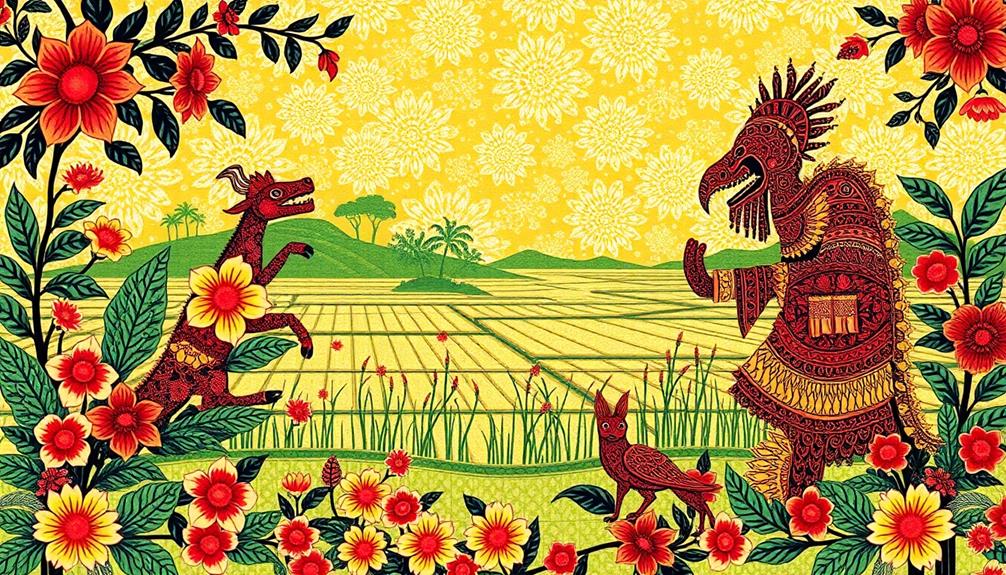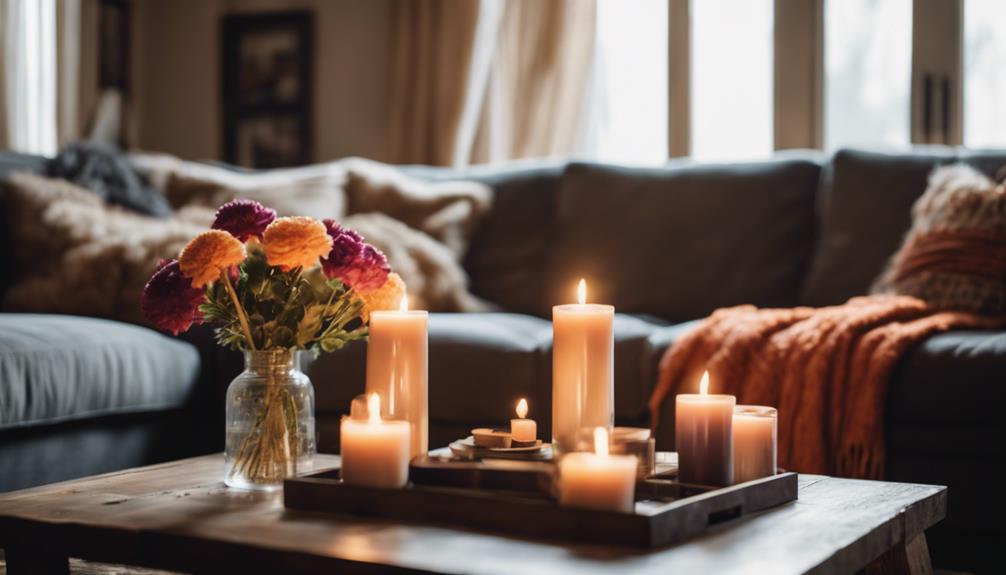Popular themes in Indonesian art showcase a vibrant blend of cultural influences. You'll notice elements from Hindu-Buddhist traditions alongside Islamic motifs, especially in batik and wayang kulit. Nature plays a vital role, with artworks featuring tropical landscapes and environmental messages. Mythology and folklore, rich in narrative, often highlight creatures like Garuda and Naga. Additionally, spirituality deeply influences the art, reflecting ancestral traditions. As you explore, you'll find traditional styles evolving into contemporary expressions, emphasizing both cultural identity and modern social themes. There's so much more to discover about these enthralling themes and their significance.
Key Takeaways
- Indonesian art showcases historical influences from Hindu-Buddhist traditions, Islamic teachings, and colonial impacts, shaping its diverse expressions.
- Nature motifs are prevalent, emphasizing environmental conservation through flora, fauna, and contemporary critiques of ecological issues.
- Mythology and folklore are central themes, illustrated through vibrant narratives in Kamasan, Wayang Kulit, and various art forms.
- Cultural identity is preserved through traditional practices like batik and Wayang Kulit, fostering community engagement and storytelling across generations.
- Modern artistic expressions blend traditional motifs with contemporary techniques, addressing social issues and promoting activism in urban settings.
Historical Influences on Art

Indonesian art has been shaped by a rich tapestry of historical influences that weave together diverse cultural threads. Starting with the Hindu-Buddhist traditions around the 7th century, these early influences laid the groundwork for artistic expressions that flourished during the Majapahit kingdom.
This period marked a golden age, where advancements in sculpture, dance, and intricate batik designs showcased a blend of local and foreign elements. The colors and patterns found in traditional Batik reflect both the artistry and cultural heritage of Indonesia, contributing to the nation's unique artistic identity, as seen in Indonesian decorative pillows.
When Islam arrived in the 15th century, it transformed art forms, particularly through shadow puppetry, known as wayang kulit. This non-figurative style emerged to align with Islamic teachings against depicting human forms, yet it retained its cultural significance.
The Dutch colonial period from 1815 to 1920 introduced Western techniques and themes, enriching traditional Indonesian styles. Artists like Raden Saleh exemplified this blend, merging European influences with local artistry.
Today, contemporary Indonesian art continues to reflect these historical influences while addressing modern social and political themes. As you explore the evolution of Indonesian art, you'll see how these historical threads create a vibrant and dynamic artistic landscape that remains deeply connected to its roots.
Nature and Environmental Motifs
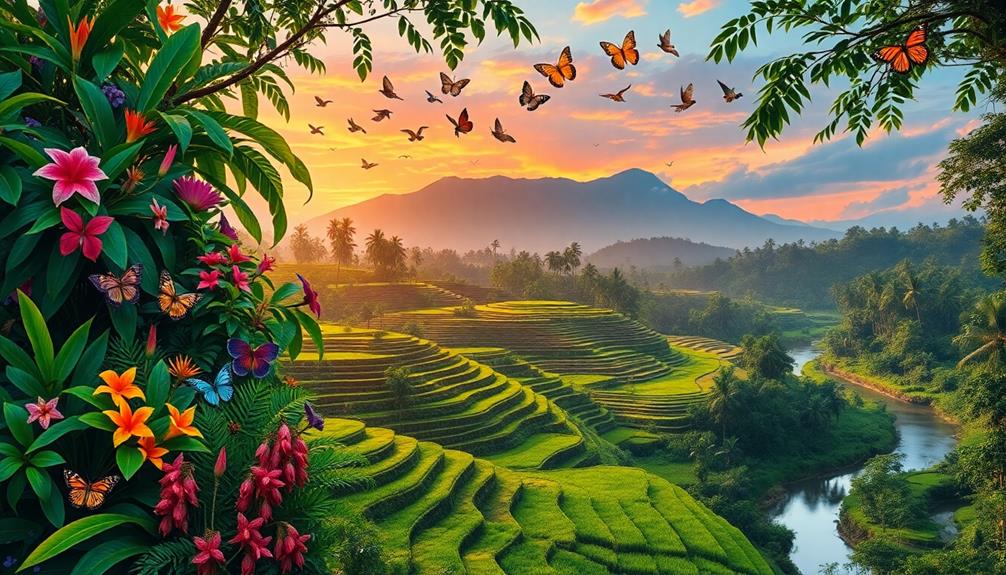
In Indonesian art, you'll notice a powerful connection to nature that goes beyond mere representation.
Artists often use symbolism to convey messages about environmental conservation and the beauty of tropical landscapes.
This deep appreciation for nature is also reflected in the craftsmanship of traditional handicrafts, such as the intricately designed Face Indonesian Decor Mask, which embodies cultural heritage while celebrating the environment.
Symbolism in Nature
Nature plays an essential role in Indonesian art, reflecting the region's rich biodiversity and cultural heritage. Artists draw inspiration from various nature motifs, using flora and fauna to symbolize harmony and balance within the environment. This connection is particularly evident in Balinese art, where natural elements, like landscapes and agricultural practices, are celebrated.
Common symbols include the lotus flower, representing purity and enlightenment, and mythical creatures like the naga, intricately carved into textiles and decorations. Traditional batik designs often feature patterns of leaves, flowers, and animals, each carrying specific cultural meanings tied to the local environment.
Here's a quick overview of some popular symbols found in Indonesian art:
| Symbol | Meaning | Art Form |
|---|---|---|
| Lotus Flower | Purity and Enlightenment | Batik, Sculpture |
| Naga | Protection and Spirituality | Carvings, Textiles |
| Tropical Flora | Harmony with Nature | Paintings, Batik |
Incorporating these environmental themes into their work, contemporary artists also critique pollution, emphasizing the urgent need for ecological awareness. Overall, the symbolism in nature reveals the deep-rooted connection between art and the natural world in Indonesia.
Environmental Conservation Themes
Reflecting the pressing environmental issues of our time, contemporary Indonesian art increasingly incorporates themes of conservation. Artists use their work to address vital concerns like deforestation, pollution, and climate change, showcasing the nation's rich biodiversity and its vulnerability to environmental degradation.
For example, Tita Salina created an impactful installation using a raft made from plastic waste, compelling viewers to rethink their relationship with nature and highlighting the urgent issue of marine pollution. Additionally, the integration of natural materials in tropical villa plans can serve as inspiration for artists aiming to promote sustainability through their work.
Moreover, traditional batik techniques have evolved, now featuring eco-friendly dyes and sustainable practices that promote environmental conservation while preserving cultural heritage. Many contemporary sculptures and installations incorporate reclaimed materials, emphasizing the importance of recycling and sustainable artistic practices in the face of a global environmental crisis.
Art exhibitions across Indonesia increasingly focus on environmental conservation themes, reinforcing the interconnectedness of culture and nature. These exhibitions not only raise awareness but also inspire collective action toward sustainability, encouraging you to engage with the pressing environmental issues around you.
In a world facing ecological challenges, Indonesian artists play a significant role in advocating for a more sustainable future through their powerful, thought-provoking works.
Tropical Landscapes Representation
Tropical landscapes are a vibrant and essential aspect of Indonesian art, capturing the country's stunning biodiversity and natural beauty. Artists often draw inspiration from the lush jungles, vibrant flora, and serene beaches that characterize the archipelago. This artistic representation aligns with the principles of Balinese Interior Design Concepts, which emphasize natural materials and a connection to nature.
Here are some key elements of tropical landscapes in Indonesian art:
- Biodiversity: Artists depict a variety of plants and animals, showcasing the richness of Indonesia's ecosystems.
- Kamasan Style: This classical Balinese painting style intricately narrates daily life intertwined with tropical settings.
- Modern Expressions: Modern Indonesian artists like Raden Saleh and Affandi use expressive techniques to evoke emotions connected to nature.
- Batik Textiles: These textiles incorporate motifs of leaves, flowers, and animals, reflecting the cultural significance of nature.
- Conservation Commentary: Environmental motifs serve as a reminder of the importance of preserving nature amidst urbanization.
Through these representations, you can see how tropical landscapes in Indonesian art not only celebrate beauty but also emphasize the need for environmental conservation, making it a rich and meaningful theme in the country's artistic expression.
Mythology and Folklore Themes
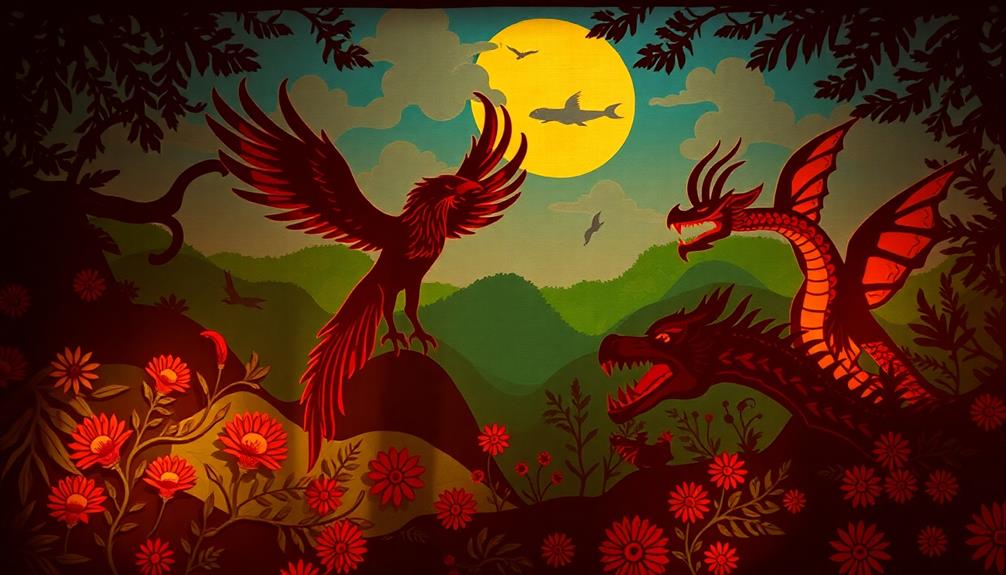
In Indonesian art, you'll find a vibrant representation of mythical creatures that embody the eternal struggle between good and evil.
These intricate designs often reflect local myths and folklore, serving as a demonstration to the country's rich cultural heritage.
Folktales come alive in visual forms, showcasing deep spiritual symbolism that connects people to their cultural roots.
This rich artistic tradition not only preserves stories but also explores the intricate relationship between mythology and everyday life, making pieces like Indonesian decor masks a perfect example of this cultural storytelling.
Mythical Creatures Representation
Mythical creatures play an essential role in Indonesian art, with many artists drawing inspiration from local mythology to create enchanting representations. These beings, like the Garuda and Naga, symbolize strength, loyalty, power, and protection. Their depiction often carries deep spiritual significance, reflecting the ongoing battle of good versus evil found in narratives such as the Ramayana and Mahabharata.
Additionally, Indonesian decor masks often incorporate these mythical figures, showcasing the intricate artistry and cultural narratives that define the region's art. Traditional artistry is evident in each piece, enhancing its story and significance.
You'll find these mythical creatures represented in various art forms, each serving a unique purpose:
- Wood carvings: Intricate designs that often act as guardians in temples.
- Batik textiles: Colorful fabric art that tells stories through patterns.
- Wayang puppet performances: Traditional shadow plays illustrating moral lessons.
- Ceramics: Decorative pottery featuring mythological themes.
- Paintings: Vibrant canvases that capture the essence of folklore.
These representations not only celebrate Indonesia's rich cultural heritage but also embody animist beliefs, intertwining traditional spirituality with artistic expression.
As you explore Indonesian art, you'll appreciate how these mythical creatures resonate within the heart of the community, serving as crucial symbols in storytelling and rituals.
Folktales in Visual Arts
Folktales breathe life into Indonesian visual arts, weaving rich narratives that capture the imagination. These stories, rooted in the country's rich heritage, often stem from the famous Hindu-Buddhist epics like the Mahabharata and Ramayana. You'll find that traditional paintings and sculptures depict these timeless tales, especially through the intricate Kamasan or Wayang style in Bali, showcasing local myths with vibrant, detailed artistry.
One of the most enchanting forms of storytelling is shadow puppetry, or wayang kulit. This art form uses stylized puppets to bring folktales to life, illustrating moral lessons and the eternal battle between good and evil.
Here's a quick look at how folktales manifest in Indonesian art:
| Art Form | Key Features |
|---|---|
| Traditional Painting | Illustrates epics and local myths |
| Shadow Puppetry | Narrates stories with stylized puppets |
| Wood Carving | Represents folklore and ancestral tales |
| Kamasan Style | Detailed character portrayals |
From mythical creatures like the naga and Garuda to elaborate wood carvings, Indonesian visual arts preserve these folktales, allowing you to connect with the culture's rich storytelling tradition.
Spiritual Symbolism Exploration
Exploring Indonesian art reveals a profound connection to spiritual symbolism, deeply intertwined with themes from mythology and folklore.
You'll notice that this art form often reflects the rich tapestry of Hindu-Buddhist influences and local beliefs, showcasing a vibrant cultural diversity.
Additionally, the artistry of Indonesian Decor Masks offers a unique insight into these spiritual themes, as many masks are crafted to embody deities and spirits, enhancing the narrative of traditional practices.
Consider these essential elements of spiritual symbolism in Indonesian art:
- Deities and Creatures: Many artworks depict figures like Garuda and naga, illustrating the intertwining of mythology and spirituality.
- Batik Patterns: Traditional batik designs feature motifs reserved for royalty, signifying cultural importance and spiritual beliefs.
- Wayang Kulit: This shadow puppetry narrates epic tales like the Mahabharata, conveying moral lessons rooted in spirituality.
- Balinese Carvings: Intricate sculptures often illustrate religious ceremonies and local myths, connecting art with daily community life.
- Ancestral Spirits: In outer islands, representations of ancestral spirits highlight animist influences, showcasing the archipelago's rich spiritual diversity.
Spirituality and Ancestral Traditions
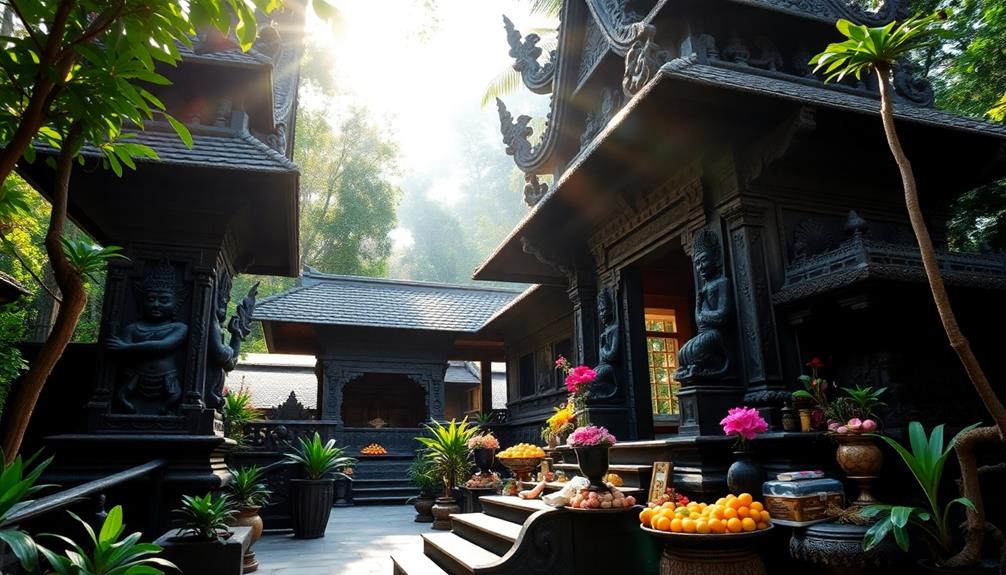
Indonesian art frequently intertwines spirituality and ancestral traditions, reflecting the nation's rich cultural tapestry. You'll find that spirituality in Indonesian art is deeply rooted in its Hindu-Buddhist heritage. Many artworks depict deities, myths, and ancient love stories that convey moral and spiritual lessons, offering insights into the collective consciousness.
Additionally, the use of natural materials in traditional art forms, such as wood and stone carvings, enhances the connection to nature and the divine, creating a harmonious balance in artistic expression. Traditional Indonesian Style Home Decor often showcases these themes, emphasizing the intricate carvings and cultural significance.
Ancestral traditions manifest in the intricate designs of textiles like batik, where specific motifs symbolize lineage and cultural stories unique to each ethnic group. Each pattern tells a story, connecting you to the past.
The practice of wayang kulit (shadow puppetry) further illustrates this connection, as it uses storytelling to explore spiritual themes and ancestral tales, revealing moral dilemmas and historical events in an engaging performance.
In regions like Bali and Java, traditional sculptures and carvings often depict mythical creatures and spiritual symbols believed to protect and guide the community.
Additionally, ritualistic dances and folk performances celebrate ancestral spirits and seek divine favor, showcasing how spirituality continues to thrive in contemporary artistic expressions.
Through these elements, you can see how spirituality and ancestral traditions remain essential in Indonesian art, creating a profound sense of identity and connection.
Cultural Identity and Community
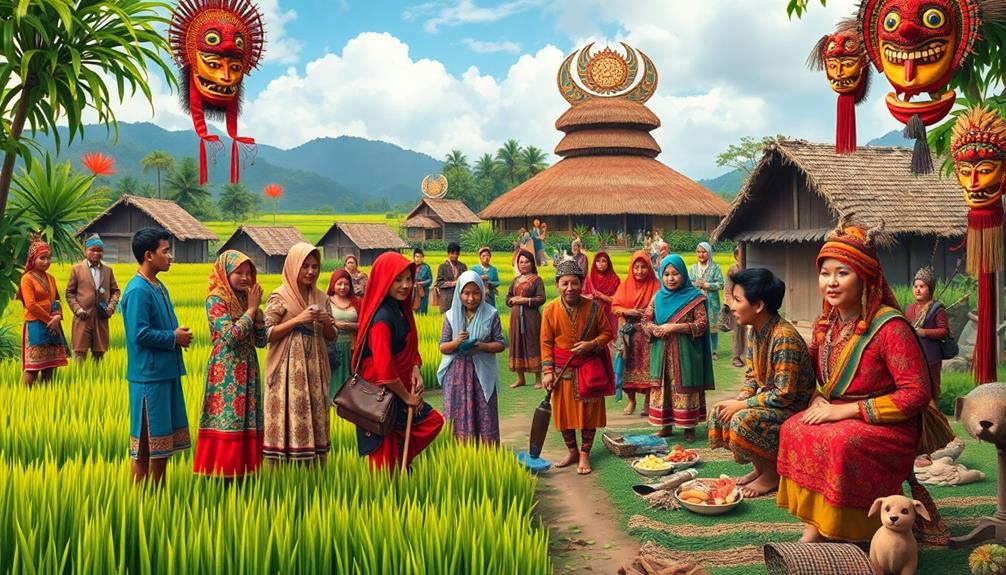
When you explore Indonesian art, you'll notice how traditional forms like Batik and Wayang kulit capture the essence of cultural identity and community.
These art forms not only preserve unique regional histories but also reflect the diverse architectural styles seen in traditional Indonesian houses, inspiring modern artists to address contemporary social issues.
Traditional Art Forms
Traditional art forms in Indonesia stand at the intersection of cultural identity and community, embodying the rich tapestry of narratives and spiritual beliefs from over 300 ethnic groups.
These art forms, like batik and wayang kulit, are essential expressions that preserve and celebrate local heritage. Many of these traditional crafts also inspire contemporary decor ideas, such as incorporating Indonesian wedding decor ideas that use batik patterns and native blooms.
- Batik: This UNESCO-recognized art involves intricate wax-resist dyeing techniques, showcasing unique patterns that signify local stories and identities.
- Wayang Kulit: Shadow puppetry that narrates epic tales such as the Mahabharata and Ramayana, linking generations through moral teachings and historical narratives.
- Regional Crafts: Balinese carvings and Javanese textiles highlight local artistic techniques while reflecting the social contexts of their communities.
- Ceremonial Significance: Many traditional art forms are performed during significant life events, such as weddings and religious festivals, reinforcing cultural bonds.
- Community Engagement: These art practices foster a sense of belonging, as individuals come together to create, celebrate, and sustain their cultural identity.
Engaging with these traditional crafts allows you to appreciate the depth of Indonesia's cultural landscape and the interconnectedness of its communities.
Modern Artistic Expressions
Amidst the vibrant tapestry of Indonesia's artistic landscape, modern artistic expressions vividly reflect cultural identity and community.
Today's Indonesian artists often blend traditional motifs with contemporary techniques, showcasing the rich heritage of over 300 ethnic groups. For instance, the resurgence of batik as both a textile and an art form highlights how modern creators experiment with colors and patterns while honoring cultural roots.
This fusion mirrors trends in traditional Indonesian housing, where cultural symbolism is deeply embedded in architectural styles.
Community engagement plays an essential role in these modern artistic expressions. Collaborative projects and performance art aren't just about creativity; they aim to address social issues and promote dialogue among diverse groups.
Artists like Eko Nugroho and Tita Salina tackle environmental concerns and identity through their work, spotlighting contemporary societal challenges while drawing from local traditions.
In urban centers like Yogyakarta, urban art movements have emerged, where street art and public installations serve as platforms for self-expression and community activism.
These works not only represent cultural identity but also foster a sense of belonging and collective action, making modern artistic expressions a powerful tool for change and reflection in Indonesian society.
Cultural Significance of Art
Art in Indonesia isn't just about aesthetics; it embodies the nation's rich cultural identity and sense of community. With over 300 ethnic groups, each contributing unique artistic expressions, Indonesian art reflects the diversity of Indonesia's cultural heritage. Traditional art forms like batik and wayang kulit play crucial roles in narrating histories and communal values.
Consider these key aspects of Indonesian art's cultural significance:
- Cultural Narratives: Art serves as a storytelling medium, conveying important cultural messages.
- Community Bonds: Traditional crafts reinforce local customs and shared identities among people.
- UNESCO Recognition: The acknowledgment of batik and wayang puppet theatre highlights their global importance in cultural preservation.
- Regional Variations: Differences in artistic styles, such as Javanese batik and Balinese carvings, showcase local traditions and daily life.
- Cultural Festivals: Events and institutions promote education and engagement with traditional art forms, ensuring their relevance today.
Through these expressions, art becomes a powerful tool for fostering community ties, preserving cultural heritage, and celebrating the rich tapestry of Indonesian identity.
Vibrant Colors and Patterns
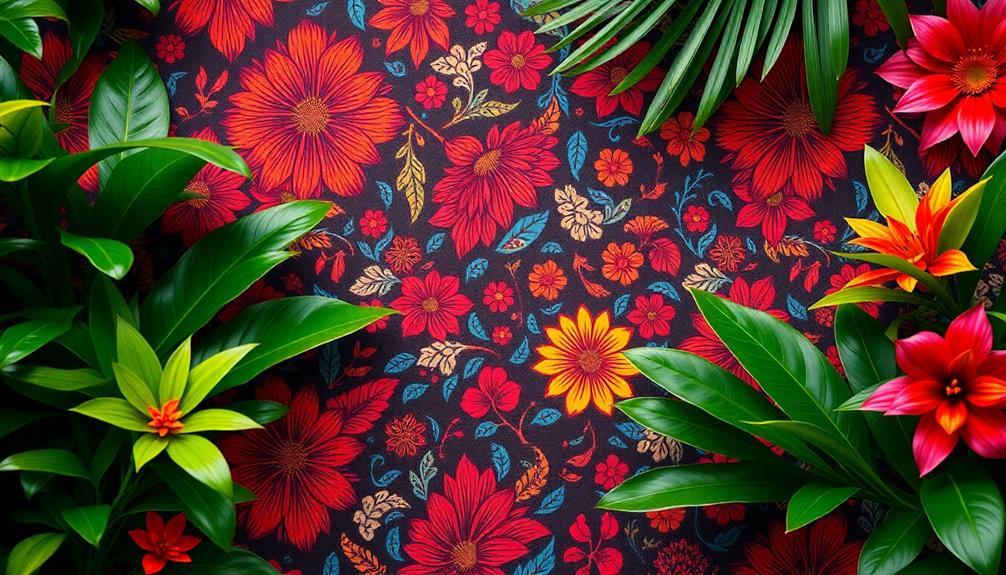
Indonesian art bursts with vibrant colors and intricate patterns that captivate the eye and reflect the country's diverse cultural tapestry. One of the most recognizable forms of this art is Batik, renowned for its intricate designs created through a unique wax-resist dyeing process. The colorful fabrics feature geometric patterns and elaborate floral themes that tell stories of the local culture.
In Balinese paintings, you'll find an abundance of bright colors and detailed patterns, often depicting narratives from Hindu mythology and local folklore. These paintings serve as visual celebrations of life and spirituality, drawing you into their enchanting worlds.
The use of vibrant colors isn't just limited to traditional forms; contemporary artists like Eko Nugroho are redefining this aesthetic by infusing three-dimensionality into graphic works. They blend popular culture with traditional themes, creating a dynamic fusion that speaks to modern audiences.
Moreover, regional variations in textile arts, like ikat and songket, showcase distinct color combinations and patterns that represent the cultural identity of different Indonesian ethnic groups. This rich diversity makes Indonesian art an inspiring visual feast.
Traditional vs. Contemporary Art
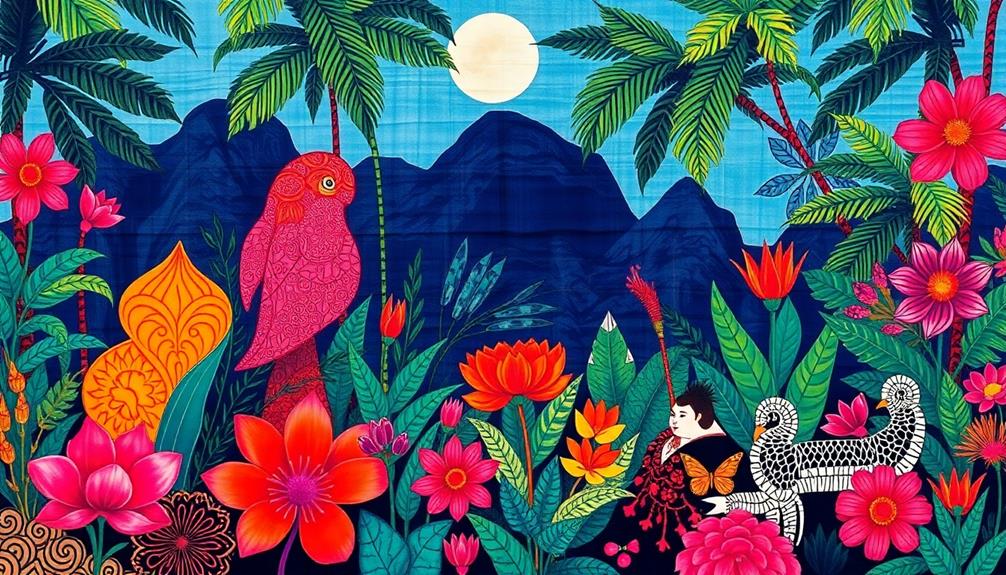
Colors and patterns in Indonesian art aren't just visually stunning; they also serve as a backdrop for a deeper exploration of traditional and contemporary expressions.
Traditional arts, like wayang kulit and batik, reflect Indonesia's rich cultural heritage, often steeped in Hindu-Buddhist themes. In contrast, contemporary art pushes boundaries, addressing modern social issues and personal identities.
Here are some key contrasts between traditional and contemporary art:
- Traditional arts often emphasize religious and cultural narratives, while contemporary art critiques modern life.
- Batik showcases ancient techniques, but contemporary artists innovate with design and themes.
- Wayang kulit storytelling remains significant, yet modern artists incorporate popular culture.
- Sculpture in traditional art tends to depict mythological figures, whereas contemporary sculpture includes abstract forms and personal narratives.
- Contemporary artists, such as Tita Salina, engage with environmental issues, showcasing a shift in focus.
This dynamic interplay between traditional and contemporary art enriches Indonesia's artistic landscape, revealing a vibrant dialogue between the past and the present.
The Role of Performance Arts
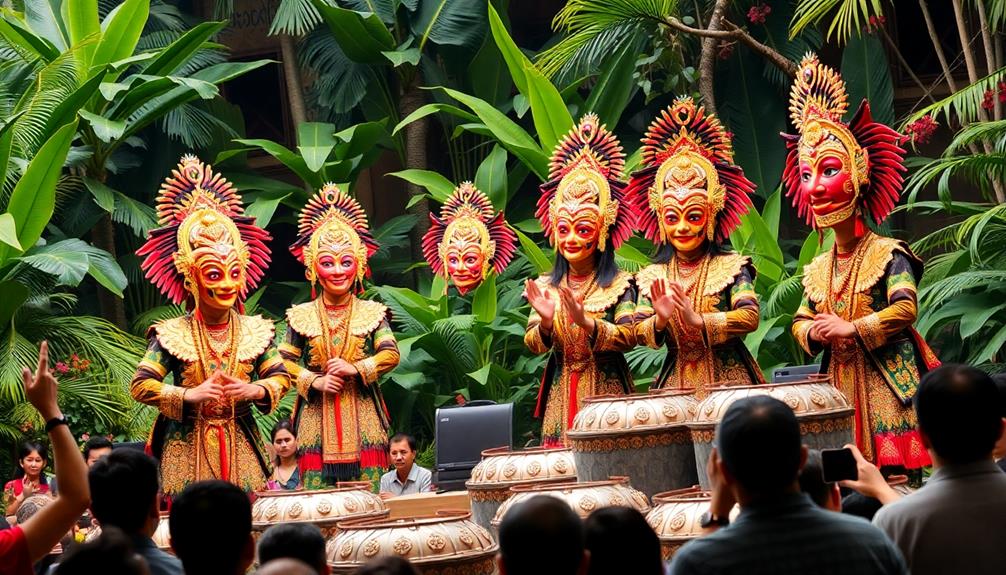
Performance arts play an essential role in Indonesia's cultural expression, with over a thousand years of history shaping their significance. Among these, wayang kulit, or shadow puppetry, stands out as a UNESCO-recognized masterpiece that brings intricate narratives from Hindu epics like the Mahabharata and Ramayana to life. These performances explore deep into cultural values, illustrating the beliefs and traditions of Indonesian society.
Dance drama also holds a crucial place in the performance arts landscape. Rooted in local customs and rituals, these performances are often showcased during significant social occasions such as weddings and festivals. You'll find regional variations like the Balinese kecak dance, which combines chanting with storytelling, and Javanese court dances, celebrated for their elegance and grace.
As contemporary performance arts evolve, they increasingly engage with modern themes and social issues, reflecting the dynamic cultural landscape. This blend of tradition and innovation highlights how performance arts not only entertain but also educate and provoke thought.
Through these diverse forms, you can truly appreciate how Indonesia's artistic expressions encapsulate its rich heritage and ongoing narrative, making performance arts a crucial aspect of the country's cultural identity.
Symbolism in Visual Arts
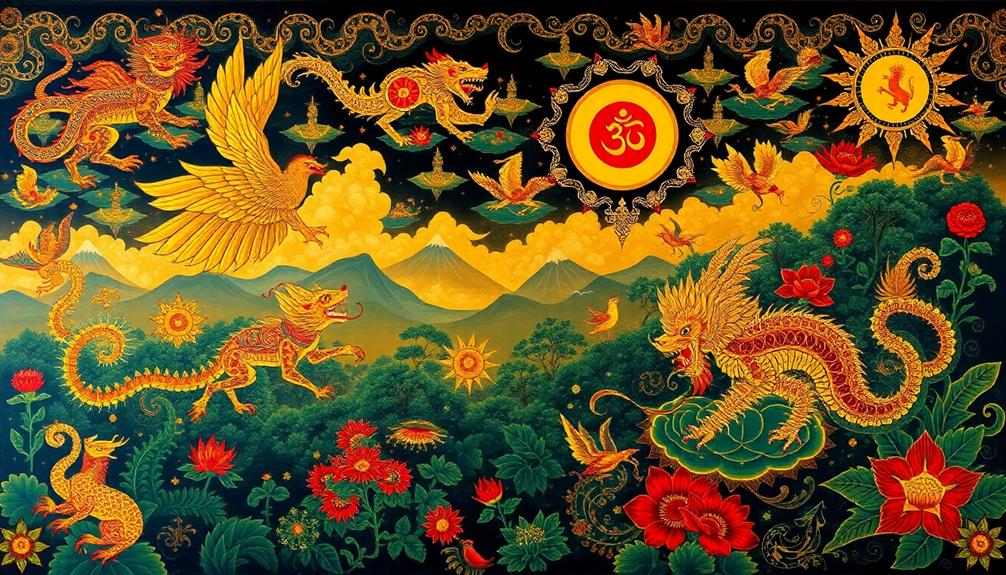
Art in Indonesia isn't just about aesthetics; it's deeply intertwined with symbolism that conveys rich narratives and cultural beliefs. When you explore Indonesian visual art, you'll notice that every piece tells a story, often steeped in mythology and tradition.
Consider these key elements of symbolism in Indonesian art:
- Mythical Creatures: Figures like the naga and Garuda represent the eternal struggle between good and evil.
- Hindu-Buddhist Influences: Traditional crafts from Java and Bali feature intricate motifs rooted in ancient texts like the Mahabharata and Ramayana.
- Batik Significance: Unique batik designs often denote social status and heritage, particularly linked to royalty.
- Islamic Art: This form emphasizes geometric patterns and calligraphy, avoiding human and animal depictions to align with religious beliefs.
- Contemporary Interpretations: Modern artists blend historical symbols with current social and political themes, reflecting a dynamic cultural identity.
The Evolution of Craftsmanship
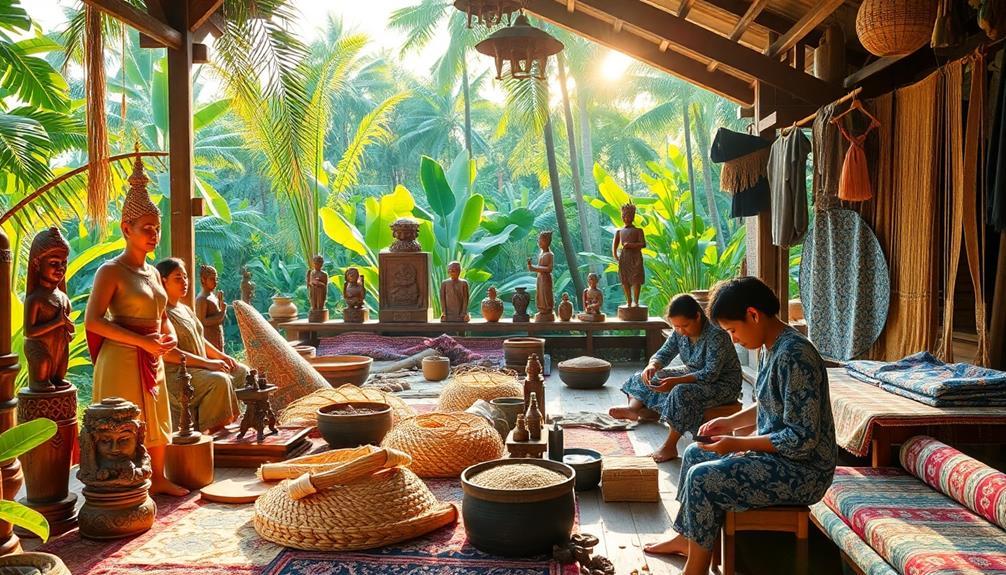
Over the centuries, Indonesian craftsmanship has undergone remarkable transformations, blending ancient traditions with modern influences. You can see this evolution in various art forms, from intricate textiles to detailed sculptures. The batik-making process, recognized as a UNESCO Intangible Cultural Heritage, showcases a complex wax-resistance dyeing technique that highlights the skill and artistry of Indonesian painters.
Furthermore, wood carving traditions from regions like Jepara and Bali demonstrate craftsmanship's adaptability. These artisans skillfully combine ancient influences with contemporary themes, creating stunning pieces that resonate with both history and modernity.
Here's a breakdown of some key aspects of Indonesian craftsmanship:
| Aspect | Description |
|---|---|
| Batik | A wax-resistance dyeing technique producing unique patterns. |
| Wood Carving | Traditional art reflecting ancient cultures and modern themes. |
| Pottery | Terracotta artifacts dating back to the Majapahit kingdom. |
Through these evolving techniques, Indonesian craftsmanship not only preserves cultural heritage but also embraces innovation, ensuring its relevance in today's artistic landscape.
Frequently Asked Questions
What Kind of Art Is Indonesia Known For?
Indonesia's known for its vibrant batik textiles, intricate Wayang puppet theater, and stunning Balinese art. You'll find expressive wooden carvings in tribal art, reflecting the rich cultural heritage and diverse artistic expressions throughout the archipelago.
What Are the 4 Themes of Art?
Like a vibrant tapestry, art unfolds four main themes: nature, cultural identity, spirituality, and social commentary. Each theme weaves together stories and experiences, inviting you to explore the rich narratives behind every creation.
What Are the Common Themes in Indigenous Art?
Indigenous art often reflects spirituality, mythology, and nature. You'll notice themes like ancestral honor, intricate patterns in textiles, and storytelling through performance, all emphasizing community connections and cultural beliefs deeply rooted in local traditions.
What Is the Characteristics of Indonesia Arts and Crafts?
Indonesia's arts and crafts showcase vibrant diversity, reflecting over 300 ethnic groups. You'll find intricate batik patterns, detailed wayang kulit puppets, and unique pottery, each telling stories of cultural significance and historical richness across the archipelago.
Conclusion
In exploring Indonesian art, you'll find a vibrant tapestry woven from historical influences, nature, and deep-rooted traditions. Each piece beckons you to immerse yourself in a world where mythology dances with spirituality, and community pride shines through every brushstroke. Curiously, as you appreciate the blend of traditional and contemporary styles, you might just stumble upon a story that resonates with your own experiences, making you feel a part of Indonesia's rich cultural narrative.
